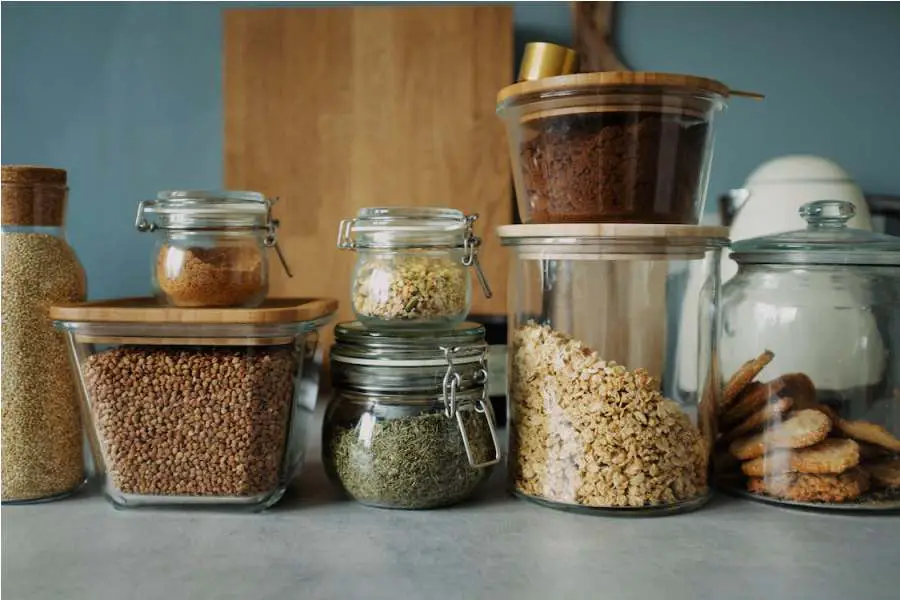
Food items in preservation containers.
Storing can go a long way to keep things intact. Some items left in a storehouse for some time bring out the uniqueness of the product.
There are so many reasons for keeping items for a while. Laying aside food commodity material to be used for a later time has been a practice in homes and the food industry. The food product may not be consumed at a moment neither will it be consumed in a day, days, or even months. At any time that food is consumed, there is a length or moment of preservation done.
The science of storage has proven to have a lot of benefits for us humans. The art of keeping things for later usage is a continuous process in life. Therefore, these practices will always continue from generation to generation.
Preserving Food Materials for Freshness
Foodstuff for culinary work needs to stay fresh so that when used in cooking the dish will taste palatable. Vegetables taken from the grocery are cleaned, washed, and kept in the refrigerator to remain fresh before usage.
If they are harvested from the farm or garden – they are also processed for storage. Vegetables are perishable by nature, how they are being stored will determine how long they will stay before their usage.
Examples of vegetables: cabbage, carrot, onion, cucumber, green pepper, green beans, parsnips, broccoli, asparagus, parsley, chives, lettuce, tomatoes, basil, rockets, rosemary, thyme, cauliflower, spinach, pakchoi, celery, leeks, bean sprout, mushroom, fennel, okra, corn, etc.
Fruits: olives, pomegranate, paw paw, pineapple, apple, raspberry, strawberry, blueberry, apricot, peach, dates, orange, banana, mango, watermelon, grapes, etc.
Tubars: sweet potatoes, Irish potatoes, etc.
Lentils: chickpeas, beans, edamame, etc..
Nuts: pistachio, groundnut, almond, walnut, peanut, etc.
Dairy Products: cheese, milk. etc.
Meat/Seafood: chicken. Pork, beef, fish, calamari, squid, shrimp, prawn, oyster, scallops, etc.
Canned/Bottled Items: soy sauce, sardine, anchovy, corned beef, plum tomatoes, jam, ketchup, baked beans, BBQ sauce, sesame oil, Worcester sauce, mayonnaise, vanilla essence, sweet corn, oyster sauce, salad cream, etc.
Grounded Food Substance: garlic powder, ginger powder, chili powder, coconut powder, stock powder, curry powder, flour, etc.
Dry Food Items: rice, pasta, noodles, etc.
Keeping For Maturity
There is a situation that prompts food stuff not to taste properly – like fruits that are harvested when they are not matured for usage. Fruits harvested prematurely when eaten cannot taste well unlike when harvested ripe. Unripe fruits are examples of food matter that are not matured for usage.
When they are in unripe condition, they are kept for some time to attain maturity. When fruits are matured or ripe, you will enjoy their sweetness.
Curing/Pickling Method
Items like “jalapeno’, and “pickled cucumber” are examples of pickled items. Some fruit items are also pickled in sugar syrup.
This process of keeping food for a duration of time has brought about another form of conservation. Applying salt on a chunk of cooked meat like pork is a process that has added a unique taste to food products. “Ham”, for instance, is processed in this manner and has become a type of food.
The substance (salt) applied to do the curing acts as preservation and develops a unique taste within the item. Though cured meat cannot stay preserved on its own like that, the product still has to be preserved under chilling or freezing conditions thereby making the item to be conserved for a very long time.
Pickling of food matter in a jar or container in a water solution (brine) has made it possible to preserve food substances in another form. For the duration, the pickled item stays in the saltwater solution (brine), adding to the content an awesome flavor.
Brine: Brine is water mixed with salt. This liquid is poured into a container or jar. Items like meat or vegetable, are placed into it. The item in the saltwater solution is influenced by the liquid. Some brine is also spiced to retain more flavorings.
Cured Meat: This type of food is made by applying salt to a chunk of meat. The chunk of meat is coated evenly with enough salt or sea salt. For some processing, take a container, pour some salt on the base, place in the chunk of meat (usually pork), and pour in more salt until the meat is covered. Set it aside for some days. What happens is that the meat will begin to lose moisture and become dry. After curing, some are wrapped with cheesecloth. Some can be vacuum packed etc.
Sun-Dry/Drying Method
Food substance that is in powdered form undergoes a process that makes it to be in that form. These substances are found in containers, jars, cellophane, etc, in household kitchens and commercial kitchens.
Substance in powdered form is known to last for a very long time. Some of these commodities are usually in solid form – they also stay longer in solid form. Their original state is a solid form before they are processed into a powdered form.
Conclusion: The storage of foodstuff has come to be in different forms of preservation. In the present day, food ideas are developed constantly. Dishes are created every day. Menus are done day by day as well. Some things are applied to items that are involved in dishes. Some processes actualize this food commodity, like “planting”.
There are seasons for planting. There is a time of nurturing plants until they yield fruit. When the time of harvesting comes, harvesting is done. Food commodities are figured out what sort or form of preservation that it has to undergo before their usage.
.

